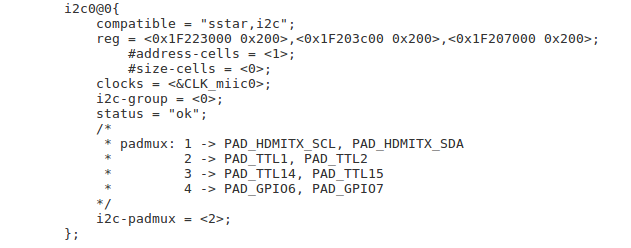I2C使用参考
1. 概述¶
表1-1
| I2C Group | SCL | SDA | DEV |
|---|---|---|---|
| HW I2C group0 | PAD_TTL1 | PAD_TTL2 | /dev/i2c-0 |
| HW I2C group1 | PAD_HDMITX_SCL | PAD_HDMITX_SDA | /dev/i2c-1 |
提供两组HW I2C,第一组HW I2C 对应pad 是PAD_TTL1/ PAD_TTL2,对应节点是/dev/i2c-0;第二组HW I2C 对应pad 是PAD_HDMITX_SCL / PAD_HDMITX_SDA,对应节点是/dev/i2c-1。
这是所有i2c全开的情况,如果实际情况中没有打开这么多i2c,要根据mhal_iic.h中“#define HAL_HWI2C_PORTS 2”的定义和infinity2m.dtsi中i2c device node的定义情况,而对应的节点一般看i2c-group = \<0>;定义的值是多少。

图1-1
下面所有的描述都是以第一组HW I2C 为例,其他 I2C 请参照第一组的使用方法。
2. 读写IC¶
通过标准的ms_i2c_xfer 函数来读写I2C,以下是一个使用的小例子。
#include <stdio.h> #include <linux/types.h> #include <stdlib.h> #include <fcntl.h> #include <unistd.h> #include <sys/types.h> #include <sys/ioctl.h> #include <errno.h> #include <assert.h> #include <string.h> #include <linux/i2c.h> #include <linux/i2c-dev.h> #define FILE_NAME "/dev/i2c-0" static int i2c_write(int fd,unsigned char slave_addr, unsigned char reg_addr, unsigned char value) { unsigned char outbuf[2]; struct i2c_rdwr_ioctl_data packets; struct i2c_msg messages[1]; messages[0].addr = slave_addr; messages[0].flags = 0; messages[0].len = sizeof(outbuf); messages[0].buf = outbuf; /* The first byte indicates which register we‘ll write */ outbuf[0] = reg_addr; /* * The second byte indicates the value to write. Note that for many * devices, we can write multiple, sequential registers at once by * simply making outbuf bigger. */ outbuf[1] = value; /* Transfer the i2c packets to the kernel and verify it worked */ packets.msgs = messages; packets.nmsgs = 1; if(ioctl(fd, I2C_RDWR, &packets) < 0) { perror("Unable to send data"); return 1; } return 0; } static int i2c_read(int fd, unsigned char slave_addr, unsigned char reg_addr, unsigned char *value) { unsigned char inbuf, outbuf; struct i2c_rdwr_ioctl_data packets; struct i2c_msg messages[2]; /* * In order to read a register, we first do a "dummy write" by writing * 0 bytes to the register we want to read from. This is similar to * the packet in set_i2c_register, except it‘s 1 byte rather than 2. */ outbuf = reg_addr; messages[0].addr = slave_addr; messages[0].flags = 0; messages[0].len = sizeof(outbuf); messages[0].buf = &outbuf; /* The data will get returned in this structure */ messages[1].addr = slave_addr; messages[1].flags = I2C_M_RD/* | I2C_M_NOSTART*/; messages[1].len = sizeof(inbuf); messages[1].buf = &inbuf; /* Send the request to the kernel and get the result back */ packets.msgs = messages; packets.nmsgs = 2; if(ioctl(fd, I2C_RDWR, &packets) < 0) { perror("Unable to send data"); return 1; } *value = inbuf; return 0; } int main(int argc, char **argv) { int fd; unsigned int slave_addr=0, reg_addr=0, value = 0; if (argc < 4){ printf("Usage:\n%s r[w] start_addr reg_addr [value]\n",argv[0]); return 0; } fd = open(FILE_NAME, O_RDWR); if (!fd) { printf("can not open file %s\n", FILE_NAME); return 0; } sscanf(argv[2], "%x", &slave_addr); sscanf(argv[3], "%x", ®_addr); if(!strcmp(argv[1],"r")) { i2c_read(fd, slave_addr, reg_addr, (unsigned char*)&value); } else if(argc>4&&!strcmp(argv[1],"w")) { sscanf(argv[4], "%x", &value); i2c_write(fd, slave_addr, reg_addr, value); } close(fd); return 0; }